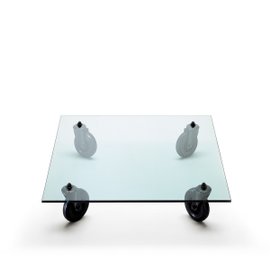Previous
Captain Flint and Extra T: Flos' and Anastassiades' treasure


Your dream house is one step away from you.
Subscribe to our newsletter and get 10% off orders of at least £100,00!
Enjoy it and don’t miss out on our offers and updates.



The exhibition dedicated to Gae Aulenti and organised by the architect’s granddaughter Nina Artioli at the Pinacoteca Giovanni e Marella Agnelli in Turin closes at the end of the month. The retrospective has a very precise starting point - the architect’s home/studio in Milan designed in 1974 - but it has endless destinations, exactly like Gae Aulenti’s life and her teaching: the importance of travelling, discovering, keeping our eyes and mind always wide open and creating works that are well-aware of the local cultural and architectural environment.
This is what Gae Aulenti (1927-2012) said in an interview a few years ago. And this is the story that the exhibition tries to represent: it is a personal, almost private exhibition, more focused on the artist and intellectual than on her works or her role as a designer.
Even the setting - the Pinacoteca of via Nizza in Torino - evokes the professional life of Gae Aulenti and her friendship with Gianni and Marella Agnelli, starting from their home in the area of Brera (Milan) up to the restoration of Palazzo Grassi in Venice.



Gae Aulenti’s career constitutes an integral part of the 20th century’s history: she worked as a scenographer for Luca Ronconi in Prato and as an art director for Fontanaarte in Milan; but she was also a supporter of the transformation of the Gare d'Orsay (Paris) into a museum, the supervisor of the restoration works in Palazzo Grassi (Venice) and of the installation of the sculpture Ago, Filo e Nodo (Needle, Thread and Knot) in Piazza Cadorna (Milan). Moreover, she designed the Catalan Art Museum of Barcelona, the Contemporary Art Museum of Istanbul and the Italian Cultural Institute and the Chancellery of the Italian Embassy in Tokyo.

Also according to Gae Aulenti herself, the museums of Barcelona and Paris are two works that enlighten part of last century’s history. The museum of Barcelona tells a typical cultural and political story of the second half of the 20th century: that of the institutional recognition of the Catalan identity.

On the contrary, the transformation of the Gare d'Orsay has been a very intense work we carried out under many pressures: it was the symbol of a time of many social, cultural and urban changes. during the construction work, said the architect, even the French President François Mitterrand used to visit us and express his opinion.
When the transformation was complete, it created a clear division between those who love it and those who don’t. It’s the ideal result. When everybody shares the same point of view, it means that something doesn’t work.

 Back to
Back to
Size*
Quantity*




